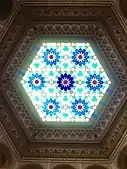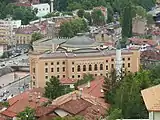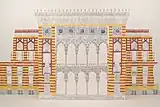Gradska vijećnica Sarajevo / Градска вијећница Сарајево | |
 Town hall in Sarajevo, August 2013 | |
| Location | Sarajevo |
|---|---|
| Designer | Karel Pařík, Alexander Wittek, Ćiril M. Iveković |
| Type | City hall |
| Beginning date | 1891 |
| Completion date | 1896 |
| Opening date | 2014 |
Sarajevo City Hall (Bosnian, Croatian and Serbian: Gradska vijećnica Sarajevo / Градска вијећница Сарајево), known as Vijećnica, is located in the city of Sarajevo, Bosnia and Herzegovina. It was designed in 1891 by the Czech architect Karel Pařík, but criticisms by the minister, Baron Béni Kállay, caused him to stop working on the project. It was initially the largest and most representative building of the Austro-Hungarian period in Sarajevo and served as the city hall.[1][2]
The building was reopened on 9 May 2014.[3] It is the current seat and headquarters of the Mayor of Sarajevo, as well as the Sarajevo City Council.
History

Alexander Wittek, who worked on the project in 1892 and 1893, fell ill and died in 1894 in Graz, and the work was completed by Ćiril Iveković. The edifice was built in a stylistic blend of historical eclecticism, predominantly in the pseudo-Moorish expression, for which the stylistic sources were found in the Islamic art of Spain and North Africa.
Building works began in 1892 and were completed in 1894, at a cost of 984,000 crowns, with 32,000 crowns provided for fixtures and fittings. It was formally opened 20 April 1896, and handed over to the City Authority, which occupied the property until 1949, when it was handed over to the National and University Library of Bosnia and Herzegovina.
On 25 August 1992, Serb shelling during the Siege of Sarajevo caused the complete destruction of the library; among the losses were about 700 manuscripts and incunabula and a unique collection of Bosnian serial publications, some from the middle of the 19th century Bosnian cultural revival.[4] Before the attack, the library held 1.5 million volumes and over 155,000 rare books and manuscripts.[5] Some citizens and librarians tried to save some books while they were under sniper fire, at least one person died.[5]

The majority of the books could not be saved from the flames. The structural repair of the building was planned to be carried out in four stages: 1996 and 1997 (financed by a donation from the Austrian state), and 2000 through 2004 (financed by a donation from the European Commission), and the city of Barcelona among others. The third stage ended in September 2012, with an estimated cost of KM 4.6 million (about €2.37 million) and will return the city hall to its former grace. The fourth stage began following the completion of the third stage and lasted about 20 months, finishing at the end of 2013 and cost of KM 14 million (about €7.23 million) which are secured through the IPA. In this stage the entire interior of the building was rebuilt and reconstructed (paintings, sculptures, books), resulting in the library being brought back to its pre-war condition. Everything that was possible to restore has been done so, while those things that were not possible to save have been made anew through special molds. The whole reconstruction and restoration process was predicted to cost about KM 25 million (about €13 million).
After it was repaired, the building, now a national monument, has been used for variety of events. Its space has been be used for various protocol events for all levels of government, concerts and exhibitions.[6]
Renewal
After years of restoration, the building was reopened on 9 May 2014, with the performance of the Sarajevo Philharmonic Orchestra and Vedran Smailović,[7] as well as a 3D projection video mapping by Knap Studio Sarajevo.[8] In 2022, it was the subject of a stop-motion animated film directed by artist Nicholas F. Callaway, through the research project Imaneo, with funding from Creative Europe.[9]
 Interior after restoration.
Interior after restoration. Stained-glass ceiling, interior after restoration.
Stained-glass ceiling, interior after restoration. Library as seen from the Yellow Fortress.
Library as seen from the Yellow Fortress. Still from Callaway's film Vijećnica.
Still from Callaway's film Vijećnica.
See also
References
- ↑ "- vijećnica -". www.vijecnica.ba. Retrieved 2018-02-21.
- ↑ Sarajevo Vijećnica Archived September 10, 2011, at the Wayback Machine
- ↑ www.oslobodjenje.ba/ Opening of the national library. Archived May 11, 2014, at the Wayback Machine
- ↑ For foreigners an event that defined the cultural objectives of the besiegers occurred during the night of August 25, 1992, the intentional shelling and utter destruction with incendiary shells of the irreplaceable Bosnia National and University Library, the central repository of Bosnian written culture, and a major cultural center of all the Balkans. Among the losses were about 700 manuscripts and incunabula and a unique collection of Bosnian serial publications, some from the middle of the 19th century Bosnian cultural revival. Libraries all over the world cooperated afterwards to restore some of the lost heritage, through donations and e-texts, rebuilding the Library in cyberspace.
- 1 2 Riedlmayer, András. "Erasing the Past: The Destruction of Libraries and Archives in Bosnia-Herzegovina". Archived from the original on 2012-01-18.
- ↑ "Vijećnica na proljeće s nekadašnjim sjajem - Klix.ba". archive.is. 2012-09-10. Archived from the original on 2012-09-10. Retrieved 2018-02-24.
- ↑ Sito-Sučić, Daria (9 May 2014). "Sarajevo reopens landmark city hall and library destroyed in war". Reuters. Retrieved 9 May 2014.
- ↑ Destination Sarajevo. "Spectacular 3D Projection Mapping - Vijećnica (City Hall) Sarajevo". YouTube. Retrieved 6 July 2022.
- ↑ Callaway, Nicholas F. "Vijećnica trailer". YouTube. Retrieved 11 August 2023.
External links
- Hartmann, Kristen M. (2016-02-08). "Fragmentation and forgetting: Sarajevo's Vijećnica". International Journal of Heritage Studies. 22 (4): 312–324. doi:10.1080/13527258.2016.1138317. S2CID 147472375.
- Riedlmayer, András (July 1995). "Erasing the Past: The Destruction of Libraries and Archives in Bosnia-Herzegovina". Middle East Studies Association Bulletin. 29 (1): 7–11. doi:10.1017/S0026318400030418. JSTOR 23061201. S2CID 164940150.
- Sarić, Šamija. "DESTRUCTION OF ARCHIVAL RECORDS IN BOSNIA AND HERZEGOVINA". - UDK 930.25:355.4](497.6)"1992/1995" - god. 42(1999), str. 223-230
